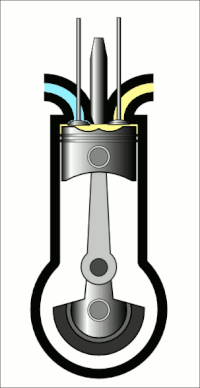
Photo from wikipedia
Stochastic temporal wandering of the spin frequency ν of a rotation-powered pulsar (i.e. the achromatic component of timing noise unrelated to interstellar propagation) affects the accuracy with which the secular… Click to show full abstract
Stochastic temporal wandering of the spin frequency ν of a rotation-powered pulsar (i.e. the achromatic component of timing noise unrelated to interstellar propagation) affects the accuracy with which the secular braking torque can be measured. Observational studies confirm that pulsars with anomalous braking indices $\vert n \vert = \vert \nu \ddot{\nu } / \dot{\nu }^2 \vert \gg 1$ exhibit elevated levels of timing noise, where an overdot symbolizes a derivative with respect to time. Here it is shown, through analytic calculations and Monte Carlo simulations involving synthetic data and modern Bayesian timing techniques, that the variance 〈n2〉 of the measured n scales with the square of the timing noise amplitude $\sigma _{\ddot{\nu }}$. The anomalous regime 〈n2〉 ≫ 1 corresponds to $\sigma _{\ddot{\nu }}^2 \gg 10^{-60} (\gamma _{\ddot{\nu }}/10^{-6} \, {\rm s^{-1}})^2 (\dot{\nu } / 10^{-14} \, {\rm Hz \, s^{-1}})^4 (\nu / 1 \, {\rm Hz})^{-2} (T_{\rm obs} / 10^8 \, {\rm s}) \, {\rm Hz}^2{\rm s}^{-5 }$, where $\gamma _{\ddot{\nu }}$ is a stellar damping time-scale, and Tobs is the total observing time. When the inequality in the above condition is reversed, n is dominated by the secular braking torque, and timing measurements return n ∼ 3, if the secular braking torque is electromagnetic. The variance 〈n2〉 is greater, when the stochastic process driving spin fluctuations differs from the red noise model (e.g. power-law spectral density) assumed in the timing solution.
Journal Title: Monthly Notices of the Royal Astronomical Society
Year Published: 2023
Link to full text (if available)
Share on Social Media: Sign Up to like & get
recommendations!